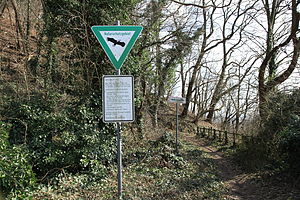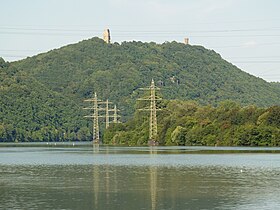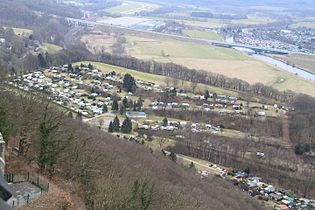Nature reserve Ruhr slopes Hohensyburg
|
NSG Ruhr slopes Hohensyburg
|
||
|
NSG access to the Syberg slope on Hengsteystraße |
||
| location | Dortmund , NRW , Germany | |
| surface | 42.9 ha | |
| Identifier | DO-018 | |
| WDPA ID | 319021 | |
| Geographical location | 51 ° 25 ' N , 7 ° 29' E | |
|
|
||
| Sea level | from 99 m to 251.5 m | |
| Setup date | 1990 | |
| Framework plan | Landscape plan Dortmund-Süd | |
| administration | Lower landscape authority of the city of Dortmund | |
The Hohensyburg partial slopes of the Ruhr are a nature reserve (NSG) in the Syburg district of Dortmund and in the Ardey Mountains . It is located on the southern border of Dortmund north of the Ruhr near the Hohensyburg . The nature reserve was first placed under protection in 1990; this was retained in the first change to the landscape plan on September 2, 2005. The nature reserve covers an area of 42.9 hectares in the form of three sub-areas. The sub-areas are separated from each other by the Ardey Forests landscape protection area. The Ruhraue Syburg nature reserve borders directly in the neighboring area of Hagen .
description
The nature reserve comprises the forested slopes of the Ruhr valley above the Ruhr and the Hengsteysee within the natural spatial unit of the Südardey walls . The heights of Klusenberg (western NSG part on the Hengsteysee), Syberg (middle NSG part below the Hohensyburg) and Boelsberg (eastern NSG part between the campsite and the railway line) descend very steeply towards the lake. The steep slopes, consisting mainly of hard Ruhr sandstone , form edges and rocky outcrops. The highest rocks reach a height of a maximum of 10 m and in a few places protrude from the crown of the adjacent low and stunted mixed deciduous forests. In addition to the natural rocks, there are also old, abandoned and re-forested quarries. In addition, the area is criss-crossed by tunnels and mouth holes of the mining industry (parts of the Syburger Bergbauweg are in the area) as well as some old, abandoned quarries such as B. the schoolmaster quarry. Due to the escaping spring water, there are some damp rock walls.
- Nature reserve
western part - Klusenberg
middle part - Syberg
eastern part - Boelsberg
The forests on the northern side of the lake consist of mixed oak forests . Some areas are covered with birch , beech and hornbeam . In the western part of the nature reserve there are blackberries and bracken in the undergrowth of the partly still young forests . The eastern parts consist of rather middle-aged beeches and hornbeams. The extremely steep slopes are overgrown with stunted sessile oaks .
Due to its location between the Hengsteysee and the Hohensyburg with the neighboring casino Spielbank Hohensyburg , the nature reserve is very popular. The steep slopes of the Ruhr are criss-crossed by footpaths that offer interesting viewpoints of the Hengsteysee and the Lenne that flows into it .
The rocks, the light oak forests and the sessile oak stocks on the steep slopes offer a valuable biotope for the wall lizard that lives here and the black stripe fern growing in the peripheral areas .
Specially protected species
In the habitat of the steep slopes of the Ruhr there is a species that is on the Red List for endangered species : the wall lizard (EU code 1256). The presence of the wall lizard is due to a release. Wall lizards in North Rhine-Westphalia only live naturally in the Rhine Valley near Bonn.
Protection goals
In this nature reserve, the preservation of the habitats in the wooded steep slopes and a nature-friendly, effective visitor guidance are crucial.
Protective measures
In the nature reserve, the designation stipulated that climbing in the NSG is prohibited. In particular, the occurrence of the wall lizard on the rocks was affected. Nevertheless, there was massive illegal climbing. In 2002, the Lower Landscape Authority in Dortmund ensured that the climbing hooks in the NSG were removed. Since then, illegal climbing activities have decreased significantly.
See also
Individual evidence
- ^ Martin Bürgener: Sheet 110: Arnsberg . In: Handbook of the natural spatial structure of Germany . 1969 ( digitized version of the corresponding map [PDF; 5.9 MB ; accessed on March 2, 2017]).
- ↑ Teachers toiled in the quarry. The West, November 6, 2011, accessed October 13, 2012.
- ↑ Ulrich Schulte: The wall lizard. Successful in tow with people. Laurenti-Verlag, Bielefeld 2008, ISBN 978-3-933066-36-7 , 52 ff
- ↑ Martin Lindner, Gisbert Lütke, Ralf Jakop, Doris Siehoff: The conflict between climbing and nature conservation in North Rhine-Westphalia (Part 2). Annual Report 2009 Working Group Peregrine Falcon Protection of NABU NRW: 18-22
Web links
- Nature reserve "Ruhrsteil slopes Hohensyburg" in the specialist information system of the State Office for Nature, Environment and Consumer Protection in North Rhine-Westphalia







